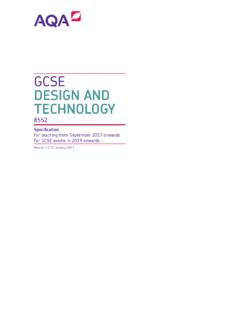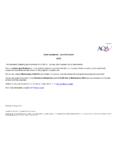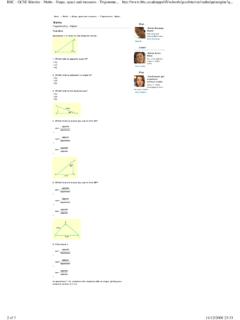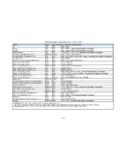Transcription of GCSE Design & Technology Lesson Element Teachers' …
1 The Activity: This resource comprises 1 task. Associated materials: Context, Design Brief and Specification Lesson Element learner worksheets. gcse Design & Technology Context, Design Brief and Specification Instructions and answers for teachers These instructions should accompany the OCR resource Context, Design Brief and Specification worksheets which supports OCR gcse Design & Technology . This activity offers an opportunity for English skills development. OCR Resources: the small print OCR s resources are provided to support the teaching of OCR specifications, but in no way constitute an endorsed teaching method that is required by the Board, and the decision to use them lies with the individual teacher. Whilst every effort is made to ensure the accuracy of the content, OCR cannot be held responsible for any errors or omissions within these resources. OCR 2014 - This resource may be freely copied and distributed, as long as the OCR logo and this message remain intact and OCR is acknowledged as the originator of this work.
2 OCR acknowledges the use of the following content: English icon: Air0 , Ski jacket: Irina , Cold person: , Fireman s jacket: Digital , Bath towels: K. Miri , Beads: , Red cross: , green tent: Africa , Soft football toy: Venus , Swimsuit: Michael , Washing machine , umbrella with water droplets: Bernd , Baby s play mat: , Football shirt: , Abc blocks: Hurst , Computer desk: , To give us feedback on, or ideas about the OCR resources you have used, email These resources have been developed in order to support students through the early stages of a Design project. Students can struggle to identify an open-ended context or problem, which limits their opportunities for creativity later on. They also often include far too much detail in their Design brief, thus narrowing their ideas. Specification writing, if not understood, can involve vague, generic points which could apply to a multitude of products. By undertaking the tasks below, students will be equipped with some of the key components towards an exciting, innovative and successful project.
3 Task 1 Understanding a context It is advisable that prior to this Lesson , students will have had a range of opportunities to explore different types of products, Design influences and user groups. The broader Design context is usually either set by the teacher or the exam board, for example, students might begin with the theme My Environment . The aim of the Design Context worksheet is for students to begin to consolidate their initial thoughts, whilst still keeping their ideas open enough to allow for innovation, creativity and development. How to write your own Design brief Discuss the meaning of the word brief and use this to help you to explain to students that the whole purpose of a Design brief is that it needs to be short and concise. Students should practise using the writing frames and examples on the Design Brief worksheet. How to write your own specification Similarly to brief , ask the students what the word specification is similar to and hopefully they will say specific.
4 Use this to reinforce the fact that a specification involves the designer giving a key bullet pointed list of specific criteria for their product. Students will need to practise writing specifications using the differentiated Specification worksheets. By the end of the Lesson , they should be confident enough to start developing specifications for their own products and start to consider justifications for those points. Additional support information When identifying a user, students may want choose themselves, a friend or a relative; they should be actively encouraged to select a group. When using the specification worksheets, a common misconception to look out for and discuss is the difference between the terms absorbent and waterproof . Student Sheets Please see the selection of student worksheets to support these activities below. Design Context Worksheet Annotated Images of Products that have inspired you Who is your intended user?
5 What are their needs? Why would they use your product? Mind map of ideas that link to your Design context Writing a Design Brief A Design brief is a short, precise way of explaining what you intend to Design , who it will be for and what its purpose will be. Below is an example of a Design brief that a designer might use when designing a bag. They would pick something from each of the three boxes and use them to complete their sentence: Eg I am going to Design and make a .. for ..to .. Have a go at writing a Design brief for the products below using the writing frame. Once you feel confident, try writing your own Design brief at the bottom of the page. A Sensory Baby Toy My own Design Brief: A Computer Desk My own Design Brief: Name of Product Rucksack Satchel Shoulder bag Drawstring bag User Group Teenage girls Teenage boys Teenagers Teenagers Purpose Store their .. in Carry their .. Transport .. Protect .. drawstring bag carry their PE kit in teenagers I am going to Design and make a.
6 For .. I am going to Design and make a .. for .. Writing a Specification (Lower Ability) Below is some information about different products and their specification points. You need to cut them up and then stick them into the table in the correct place. Bath Towel Must be able to absorb water Needs to be insulating Needs to be educational Baby s Play Mat Needs to be waterproof Ski Jacket Must be machine washable Must have no small parts Name of product Picture Specification Point 1 Specification Point 2 Name of product Picture Specification Point 1 Specification Point 2 Writing a Specification (Average Ability) Look at the products below. Each one has two specification points below that apply to them. Once have put these into the correct place can you add your own third specification point for each item and justify one of the points? Must be able to absorb water Must have no small parts Needs to be insulated Must be machine washable Needs to be educational Needs to be waterproof Bath Towel 1 2 3 1 2 3 Baby s Play Mat 1 2 3 Ski Jacket Writing a Specification (Higher Ability) For each of the products below, come up with three important specification points that the designer should consider, justifying those points.
7 Fireman s Jacket 1 2 3 Swimming Costume 1 2 3 Football Shirt 1 2 3 Tent 1 2 3

















